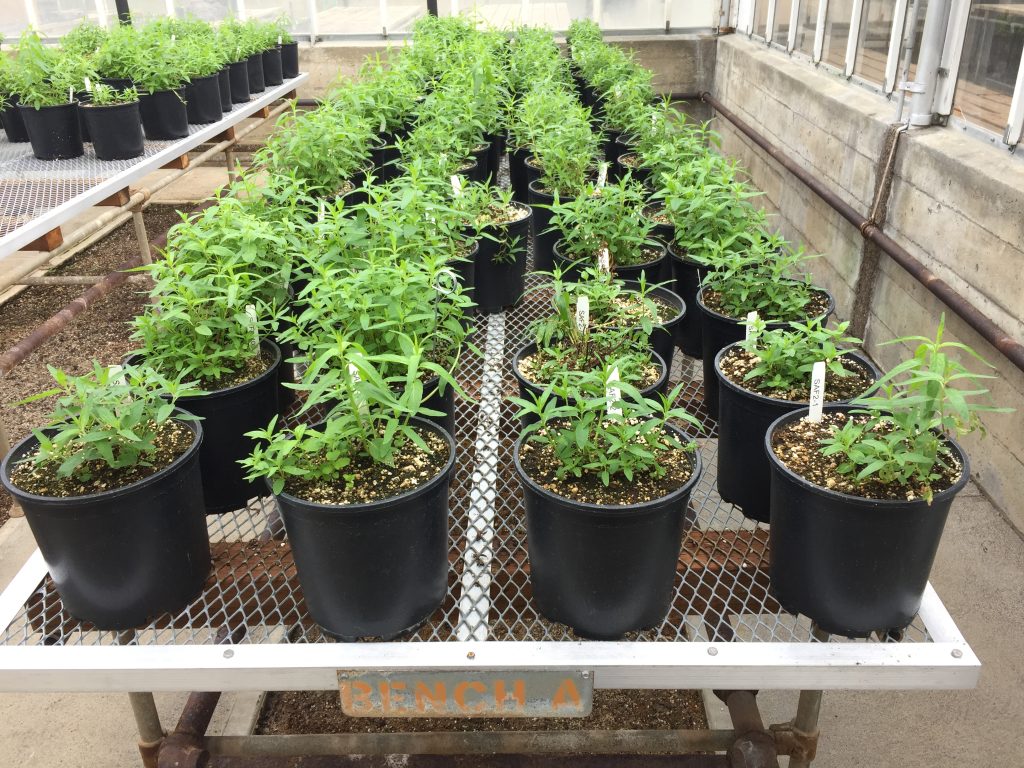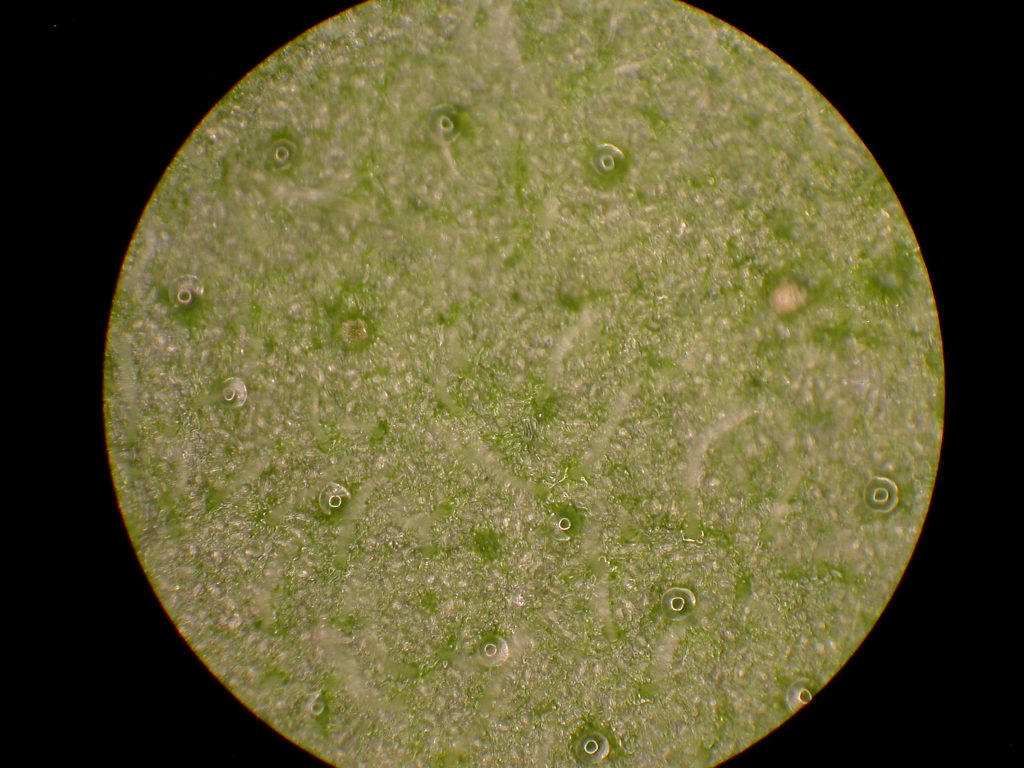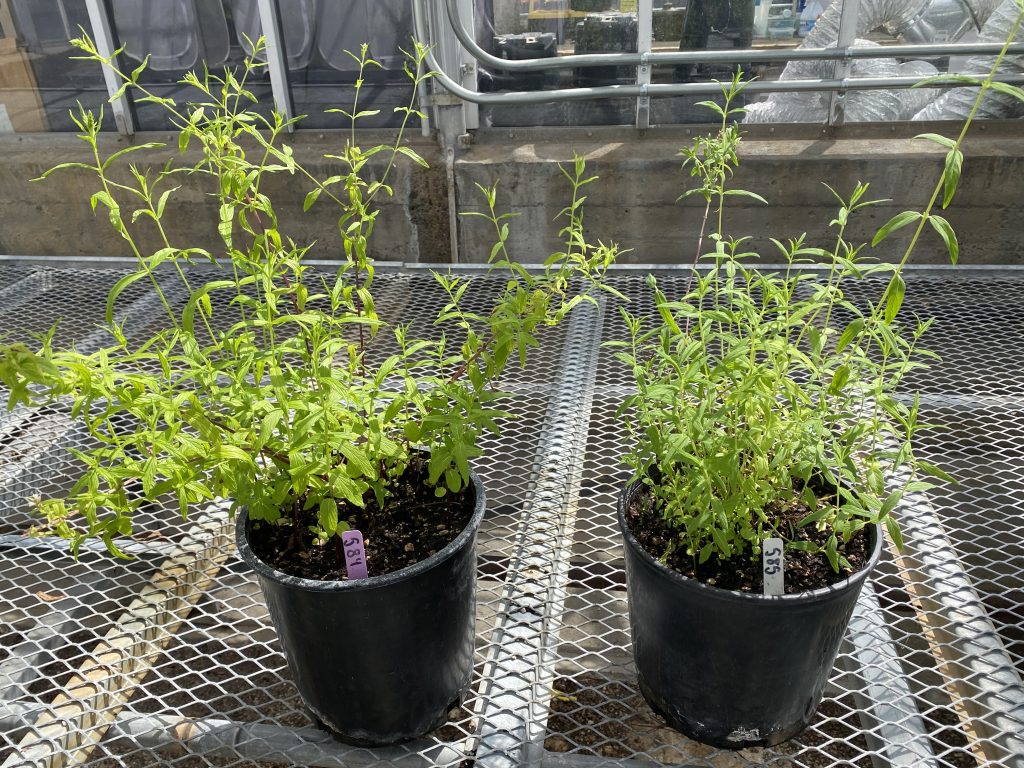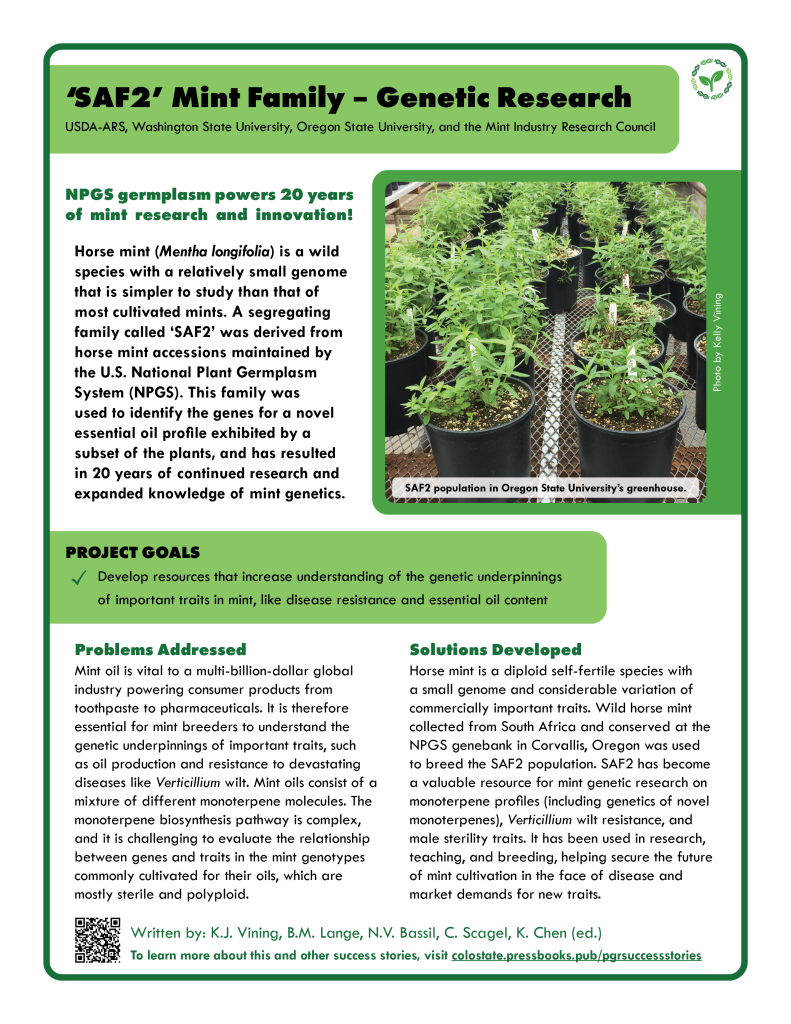Spices and Herbs
‘SAF2’ Mint Family – Genetic Research
USDA MINT GERMPLASM CONTRIBUTES TO UNDERSTANDING OF OIL COMPOSITION GENETICS
Kelly J. Vining; Bernd Markus Lange; Nahla V. Bassil; and Carolyn Scagel
Department of Horticulture, Oregon State University, 2750 SW Campus Way, Corvallis, Oregon 97331.
Institute of Biological Chemistry, Washington State University, Pullman, Washington 99164.
USDA-ARS National Clonal Germplasm Repository, 33447 Peoria Rd, Corvallis, Oregon 97333.
Corresponding author: kelly.vining@oregonstate.edu
OUTLINE
1. SUMMARY

Horse mint (Mentha longifolia) is a wild species with a relatively small genome that is simpler to study than that of most cultivated mints. A segregating family called ‘SAF2’ (South African F2) was derived from horse mint accessions maintained by the U.S. National Plant Germplasm System (NPGS) mint germplasm collection. This family was used to identify the genes for a novel essential oil (monoterpene) profile exhibited by a subset of the plants. This information leverages mint crop wild relatives to answer questions about the biosynthesis of commercially important traits, and has resulted in 20 years of continued research and expanded knowledge of mint genetics.
The goals of this project were to develop resources that increase understanding of the genetic underpinnings of important traits in mint, like Verticillium wilt disease resistance and essential oil content. These resources can be used by plant breeders to address many industry needs.
Download a printable fact sheet by clicking the image below.
2. PROBLEMS ADDRESSED

Mint is cultivated for its distilled essential oil, which is vital to a multi-billion-dollar global industry powering consumer products from chewing gum to toothpaste, pharmaceuticals, cosmetics, and more. These oils consist of a mixture of different monoterpene molecules. The primary monoterpene in spearmint is carvone, while menthol and related monoterpenes are predominant in peppermint. The main genes in the monoterpene biosynthesis pathway are known and their activities are well-studied; however, the pathway is complex, and uncharacterized variants of these genes can lead to novel oil types. Principal mint genotypes cultivated for their essential oils (M. spicata, Mentha × piperita, Mentha × gracilis, and M. canadensis) are mostly sterile and polyploid, making evaluations that connect genes and traits challenging.
3. SOLUTIONS DEVELOPED

Horse mint, a diploid self-fertile species with a small genome, exhibits considerable variation for commercially important traits such as essential oils and tolerance to the disease Verticillium wilt. A Mentha longifolia family, SAF2, was developed from a wide cross between two M. longifolia accessions collected from the wild in South Africa and conserved at the USDA National Clonal Germplasm Repository (NCGR) in Corvallis, Oregon. Parent CMEN 585 is Verticillium wilt resistant and produces the monoterpene pulegone. Parent CMEN 584 is highly wilt-susceptible and produces carvone. This SAF2 family is a valuable resource for mint genetic research on Verticillium wilt resistance, monoterpene profiles, and male sterility traits. Aided by the development of a high-quality reference genome from CMEN 585, a genome-wide association study was conducted to find variants of two genes (limonene-6-hydroxylase and isopiperitenone reductase) that explained the accumulation of piperitenone oxide (a novel monoterpene not present in either parents) in seven progeny from this family.
Collaborators involved in developing solution:
- B. Markus Lange, Amber N. Parrish, Iris Lange, Yanmei Xiao, Haixiao Dong, Zhiwu Zhang, Sümeyye Carkit-Yilmaz, Narayanan Srividya, Washington State University, Pullman, Washington, USA
- Iovanna Pandelova, Kelly J. Vining, Oregon State University, Corvallis, Oregon, USA
- Mint Industry Research Council, Salem, Oregon, USA
4. IMPACT
Over the past 20 years, this SAF2 family has generated new knowledge of mint genetics, oil profiles and has the potential to uncover genetic control of Verticillium wilt resistance. It has been used in research, teaching, and by plant breeders for marker assisted selection. SAF2 parent CMEN 585 was the first-ever mint to have its genome sequenced (Vining et al., 2017). This effort spurred the continuing development and updating of genome resources for mint, including the first draft of the hexaploid genome of ‘Black Mitcham’ peppermint, historically the predominant commercial cultivar. By tapping into the unique value of wild germplasm, the National Plant Germplasm System provided the foundation for scientific discovery and tangible breeding solutions, helping secure the future of mint cultivation in the face of disease and market demands for new traits.
5. GERMPLASM
Two genebank accessions, originally collected in South Africa, were maintained at the NCGR in Corvallis, Oregon and used to develop the SAF2 population:
- PI 557767 (CMEN 585) Mentha longifolia (L.) Huds. subsp. capensis (Thunb.) Briq.
- PI 557769 (CMEN 584) Mentha longifolia (L.) Huds. subsp. polyadena (Briq.) Briq.
6. REFERENCES
Lange BM, Parrish AN, Lange I, Xiao Y, Pandelova I, Dong H, Zhang Z, Carkit-Yilmaz S, Davis TM, Wüst M, Srividya N, Vining KJ. 2025. Transgressive segregation affects essential oil composition in a model mint population. New Phytologist 247:1564–1571. https://doi.org/10.1111/nph.70305
Vining K, Zhang Q, Tucker A, Smith C, Davis T. 2005. Mentha longifolia (L.) L.: A model species for mint genetic research. HortScience 40:1225–1229. https://doi.org/10.21273/HORTSCI.40.5.1225
Vining KJ, Johnson SR, Ahkami A, Lange I, Parrish AN, Trapp SC, Croteau RB, Straub SCK, Pandelova I, Lange BM. 2017. Draft genome sequence of Mentha longifolia and development of resources for mint cultivar improvement. Molecular Plant 10:323–339. https://doi.org/10.1016/j.molp.2016.10.018
Vining KJ, Hummer KE, Bassil NV, Lange BM, Khoury CK, Carver D. 2020. Crop wild relatives as germplasm resource for cultivar improvement in mint (Mentha L.).Frontiers in Plant Science 11:1217. https://doi.org/10.3389/fpls.2020.01217
Vining KJ, Pandelova I, Lange I, Parrish AN, Lefors A, Kronmiller B, Liachko I, Kronenberg Z, Srividya N, Lange BM. 2022. Chromosome-level genome assembly of Mentha longifolia L. reveals gene organization underlying disease resistance and essential oil traits. G3 Genes|Genomes|Genetics 12:jkac112. https://doi.org/10.1093/g3journal/jkac112
7. CHAPTER INFORMATION
Citation: Vining KJ, Lange BM, Bassil NV, Scagel C. 2025. ‘SAF2’ Mint Family – Genetic Research. In: Volk GM, Chen K, Byrne P (Eds.) Plant Genetic Resources: Success Stories. Fort Collins, Colorado: Colorado State University. Date accessed. Available from https://colostate.pressbooks.pub/pgrsuccessstories/chapter/saf2-mint-family-genetic-research/
Content originally submitted: July 29, 2025
Date of publication: September 24, 2025
USDA is an equal opportunity provider, employer, and lender. Mention of trade names or commercial products in this article is solely for the purpose of providing specific information and does not imply recommendation or endorsement by the U.S. Department of Agriculture.


